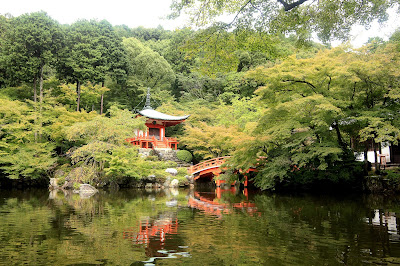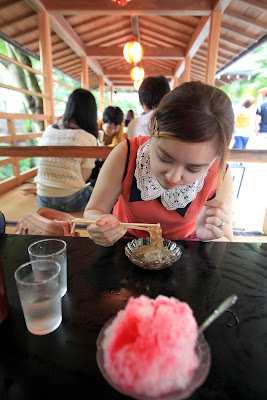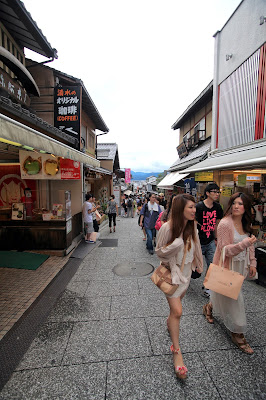Hey there!
We visited Kyoto again. If you wanna know where we went on the first day click here. We are truly in love with Kyoto that we think 2 days isn't enough. We have not visited Nara, Ginkaku-ji, Philosopher's Path, Ryoan-ji and many more. We hope to visit again when hubby is not on a working trip and we can spend more days in the city.
The first day we were here we explored the north side of the city. This time we explored the southern side. I would urge you to visit Nara if you have time.
Having my instant breakfast as usual. Since we covered Gion previously, hubby found a replacement which was the autumn pavillion I used as my wallpaper, Daigo-ji. First, we will ride to Inari station at ¥950. You can refer to my previous post to see the journey from Itami. It's about the same.
Fushimi Inari, famous for Memoirs of Geisha shooting site, is just opposite of Inari station. It is open at all times and has no entrance fees which is the best tourist attraction in Kyoto for me. Other places need to walk a long distance from the station.
At the shrine's entrance stands the Romon Gate, which was donated in 1589 by the famous leader Toyotomi Hideyoshi. Beyond the arch and gate stands the shrine's main building, Honden and various auxiliary buildings.
Fushimi Inari is the most important of thousands of shrines dedicated to Inari, the Shinto god of rice. Foxes are thought to be Inari's messengers, resulting in many fox statues across the shrine grounds.
This popular shrine is said to have as many as 32,000 sub-shrines (bunsha) throughout Japan. As what I have seen, it's countless here.
Can't read what it says but what the heck. Just make sure you purchased the right amount then you can exit already. You might wanna read my guide on taking trains in Japan.
We
reached Daigo-ji at last. It was a huge space. Need to pay ¥600 for entrance fee
and we didn't know it. Sigh! Malaysian temples don't charge entrance
fees pun.
After the entrance where they charge you, you will find this serene looking path. Looks very calm and peaceful as there's no tourist but I'm sure pretty scary at night.
A short walk further into the temple grounds gets you to the Shimo Daigo area. Among them is this Kondo Hall, which was originally built in 926. It was advertised everywhere that Hitachi sponsored their roofs lol!
Also
in the Shimo Daigo area stands this 38 meter tall, five storey pagoda
that is Kyoto's oldest verified building. and stores the temple's main
object of worship, a seated statue of the Yakushi Buddha.
A little walk towards the end and finally reached Bentendo Hall. This is situated right behind of the temple grounds.
We did not go further up because afraid it might rain again. We checked the hourly weather of Itami, Osaka, Kyoto and Kobe every night so you guess how bad was the weather condition. Be warned not to visit Japan in September.
View of a temple from the red bridge then we walked a long journey back to subway station for more transfer.
We visited Kyoto again. If you wanna know where we went on the first day click here. We are truly in love with Kyoto that we think 2 days isn't enough. We have not visited Nara, Ginkaku-ji, Philosopher's Path, Ryoan-ji and many more. We hope to visit again when hubby is not on a working trip and we can spend more days in the city.
The red torii gates of Fushimi Inari is a prominent landmark in Kyoto. It is a must to visit such a beauty.
The first day we were here we explored the north side of the city. This time we explored the southern side. I would urge you to visit Nara if you have time.
Having my instant breakfast as usual. Since we covered Gion previously, hubby found a replacement which was the autumn pavillion I used as my wallpaper, Daigo-ji. First, we will ride to Inari station at ¥950. You can refer to my previous post to see the journey from Itami. It's about the same.
Fushimi Inari, famous for Memoirs of Geisha shooting site, is just opposite of Inari station. It is open at all times and has no entrance fees which is the best tourist attraction in Kyoto for me. Other places need to walk a long distance from the station.
At the shrine's entrance stands the Romon Gate, which was donated in 1589 by the famous leader Toyotomi Hideyoshi. Beyond the arch and gate stands the shrine's main building, Honden and various auxiliary buildings.
Fushimi Inari is the most important of thousands of shrines dedicated to Inari, the Shinto god of rice. Foxes are thought to be Inari's messengers, resulting in many fox statues across the shrine grounds.
This popular shrine is said to have as many as 32,000 sub-shrines (bunsha) throughout Japan. As what I have seen, it's countless here.
Bells, bells, and more bells. You just can't miss a bell in any Japanese temple you visit.
We
get to witness prayers going on and the young high priest was damn
cute. Photos not allowed at this temple so I spent my time "washing my
eyes".
Thanks to the counter which supported our camera.
Donate at any amount then write your wish on the fox heads and hang here.
Here's
the start of the hike uphill to the famous endless rows of torii gates
which takes about 3-4 hours up and back, however, visitors are free to
walk just as far as they wish before turning back. Along the way, there
are multiple smaller shrines with stacks of miniature torii gates that
were donated by visitors with lesser budget.
Yet another pitstop and another shrine. We spent about 2 hours in Fushimi so plan your time wisely. Fushimi
Inari became the object of Imperial patronage during the early Heian
period. In 965 Emperor Murakami decreed that messengers carry written
accounts of important events to the guardian kami of Japan. These
heihaku were initially presented to 16 shrines including the Inari
Shrine.
Let's
begin with the large Torii gates. The torii gates along the entire
trail are donations by individuals and companies, and you will find the
donor's name and the date of the donation inscribed on the back of each
gate. A giant one like this costs over ¥1million.
So
here we are at the parallel row of gates called Senbon Torii but which
way to take? Any one of these two will lead you up to the top of the hill.
So we took the left Senbon Torii then when came to an interval we made a
u-turn to the right one. Each of these small ones costs ¥400,000.
From
1871 through 1946, Fushimi Inari-taisha was officially designated one
of the Kanpei-taisha meaning that it stood in the first rank of
government supported shrines.
The
earliest structures were built in 711 on the Inariyama hill in
southwestern Kyoto, but was re-located in 816 on the request of the monk
Kūkai. The main shrine structure was built in 1499. At the bottom of
the hill are the main gate (Romon) and the main shrine (Honden). Behind
them at mid mountain the inner shrine (Okumiya) is reachable by a path
lined with thousands of torii. To the top of the mountain are tens of
thousands of mounds (Tsuka) for private worship.
I forgot to jump at most places but not here.
At
the train station to a slot-in-destination hubby planned overnight,
Daigo-ji. This looks like breakfast but they were actually our pitiful
lunch coz we wanted to save as much time as possible. So yeah the schedule is a very hectic one. The penguin bun is super cute tho.
It
was a long long journey from Inari station. We transited Tofukuji
station via Nara line then walked to this subway station, Rokujizo. Now
he is buying to Daigo station via Tozai line.
There's an anime fair happening!
We walked like 20minutes up the sloppy hill passed housing estates and cemeteries.
After the entrance where they charge you, you will find this serene looking path. Looks very calm and peaceful as there's no tourist but I'm sure pretty scary at night.
A short walk further into the temple grounds gets you to the Shimo Daigo area. Among them is this Kondo Hall, which was originally built in 926. It was advertised everywhere that Hitachi sponsored their roofs lol!
A little walk towards the end and finally reached Bentendo Hall. This is situated right behind of the temple grounds.
We did not go further up because afraid it might rain again. We checked the hourly weather of Itami, Osaka, Kyoto and Kobe every night so you guess how bad was the weather condition. Be warned not to visit Japan in September.
View of a temple from the red bridge then we walked a long journey back to subway station for more transfer.
After sleeping in Kyoto City Bus for like an hour, we had a long hike uphill again.
Man-powered trishaw is very common in this city. Sometimes you can see women trishaw carriers too!
Somewhere
midway after you hike up the sloppy road, tourist shops will be there
to welcome you. They might take you extra half an hour or more.
Entrance into the main temple where there's this famous platform. The story goes like if you jump down from the platform and survived, your wish will come true. But DO NOT ever attempt to jump. Following pictures will show you why.
From the main temple, you get to view this red pagoda. I believe it's just been repainted because the Japan tourism site shows it was greyish brown wood colour.
If you walk up the stairs you will find Jishu shrine dedicated to Ōkuninushi, a god of love. Jishu Shrine possesses a pair of love stones placed 6 meters apart which lonely visitors can walk between with their eyes closed. Success in reaching the other stone with their eyes closed implies that the pilgrim will find love. We did not go up coz we don't need this lol!
I saw very relaxing traditional platform where you can enjoy your dessert close to nature so I immediately dragged him when I found an empty slot. Our dessert was quite expensive considering the portion and ingredients. I believe we paid for the ambiance. I had kudzu kiri (Japanese arrowroot noodle) while hubby had what we called ais kacang without the kacang.
Beneath the main hall is the Otowa waterfall, where three channels of water fall into a pond. Visitors can catch and drink the water, which is believed to have wish-granting powers. Don't know how true is this but whats to lose in giving a try?
If you walk down from the temple, stay to you right and you will come upon this beautiful street. You can easily miss this entrance. I accidentally saw this lane from Google Earth and it was damn breathtaking. It will also lead you straight to Gion with just 15 minutes walk.
Somewhere
midway after you hike up the sloppy road, tourist shops will be there
to welcome you. They might take you extra half an hour or more.
Arrived at Kiyimizudera. Entrance fees on normal days: ¥300. Entrance during autumn: ¥400.
One of the shrines in this area but prohibited to enter.
If you want to see random girls or aunties in yukata come to Kiyomizu temple.
From here you can also get a great view of Kyoto Tower and the cityscape.
There are like a hundred of big and mini shrines and pagodas in Kiyomizu grounds.
Entrance into the main temple where there's this famous platform. The story goes like if you jump down from the platform and survived, your wish will come true. But DO NOT ever attempt to jump. Following pictures will show you why.
From the main temple, you get to view this red pagoda. I believe it's just been repainted because the Japan tourism site shows it was greyish brown wood colour.
If you walk up the stairs you will find Jishu shrine dedicated to Ōkuninushi, a god of love. Jishu Shrine possesses a pair of love stones placed 6 meters apart which lonely visitors can walk between with their eyes closed. Success in reaching the other stone with their eyes closed implies that the pilgrim will find love. We did not go up coz we don't need this lol!
After you follow the arrow which leads you out of the temple you will get this side view.
Nah look how high it is. 234 jumps were recorded in the Edo period and 85.4% survived. The practice is now prohibited.
Yay! Cancel out another heritage site from the bucket list.
We walked further up towards the red pagoda (it's a 1-way-street) and got this front view.
There
are lots of child guardians with bibs around here. There's also a
picture earlier of similar child guardians by the roadside at
Arashiyama. Basically this city is very religious and full of temples
and heritage.
I saw very relaxing traditional platform where you can enjoy your dessert close to nature so I immediately dragged him when I found an empty slot. Our dessert was quite expensive considering the portion and ingredients. I believe we paid for the ambiance. I had kudzu kiri (Japanese arrowroot noodle) while hubby had what we called ais kacang without the kacang.
Trying to be sooo Japanese.
Everybody line up I pun line up lah but what's so special about the water?
Beneath the main hall is the Otowa waterfall, where three channels of water fall into a pond. Visitors can catch and drink the water, which is believed to have wish-granting powers. Don't know how true is this but whats to lose in giving a try?
Walking down fro Kiyomizudera and we bought some souvenirs.
If you walk down from the temple, stay to you right and you will come upon this beautiful street. You can easily miss this entrance. I accidentally saw this lane from Google Earth and it was damn breathtaking. It will also lead you straight to Gion with just 15 minutes walk.
Isn't the background beautiful! Makes you wanna walk down more to see the rest of the houses and shops.
Do you know that those wooden boxes on the right are dustbins?
This tiny narrow house sandwiched in between is utterly cute!
Spot the female penarik beca. Salute!
In contrast to the heritage city, Kyoto station depicts a modern and futuristic interior.
We then walked up this endless staircase to the rooftop garden...ok we took the escalator actually.
The clouds were scary. Almost every evening in Japan during our stay in the whole September we encountered typhoon.
The fusion restaurant we had dinner in a department store at Kyoto Station called Mollette.
My omelette and some fried stuff set. The omelette was oozing out succulent juice like lava when cut from the center.
Hubby's set looks appetizing too. His omelette wrapped the omurice beneath.
It's time to pay...
One of my favourite spot. We were walking straight ahead towards Gion when we decided to turn around and look back we saw this amazing view. So the next time you walk straight ahead remember to turn around who knows you might see an amazing view.
Do you know that those wooden boxes on the right are dustbins?
This tiny narrow house sandwiched in between is utterly cute!
Spot the female penarik beca. Salute!
We ended our tour quite early. There should be a musical fountain after 7pm on the brown roof but we were too early today.
In contrast to the heritage city, Kyoto station depicts a modern and futuristic interior.
We then walked up this endless staircase to the rooftop garden...ok we took the escalator actually.
The clouds were scary. Almost every evening in Japan during our stay in the whole September we encountered typhoon.
The fusion restaurant we had dinner in a department store at Kyoto Station called Mollette.
My omelette and some fried stuff set. The omelette was oozing out succulent juice like lava when cut from the center.
Hubby's set looks appetizing too. His omelette wrapped the omurice beneath.
It's time to pay...
Instant ramen for supper again! Unhealthy but delish. Finally it's time to wrap up my Japan series. No more Japan entries unless I visit the country again. As promised I will blog about my European 2nd honeymoon for the next travel entry.

















































































































Your blog looks great!
ReplyDeleteHi Kemboslice,
DeleteThank you very much
This comment has been removed by a blog administrator.
ReplyDeleteNice try but no links allowed in comments. Btw I don't go to onsen
Delete